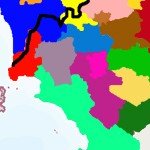Epifania, epifania, tutte le feste porta via!
That’s an old saying, meaning, literally, “Epiphany, Epifany, it takes away all the holidays”. And indeed it does. January 6th is a holiday in Italy, and the one that closes the Christmas holiday season. On the 7th, life goes back to normal (except for stores, as it marks the beginning of the winter sales!), people go back to work, kids go back to school, the Christmas decorations go back to their boxes and are stored away.
Epiphany is obviously a religious holiday: it celebrates the revelation of “God made Man in the person of Jesus Christ” and the visitation of the 3 Wise Kings to the baby Jesus. For years, in the early days of Christianity, there was a certain confusion about what was actually celebrated on January 6. For some it was Christ’s birthday, for others his baptism, and for others his first miracle in Cana. More on the history of Epiphany is available here.
What I really wanted to write about, though, is the non-religious celebrations that are so popular in Italy: La Befana. La Befana is an old woman, a witch-like character, but a good one. She brings presents to the good kids and coal and garlic to the naughty ones. She fills the stockings that they leave hanging by the fireplace (or the window, or the radiators if they don’t have a fireplace!) with candies, fruit and small presents.
In the past, this was the equivalent of what Christmas day is today. Children would receive presents only on January 6: small things, like home-made cookies, walnuts and candied figs.
I remember that I really liked the day of La Befana when I was a kid, because I would go from house to house (my grandparents, my aunts and uncles’, etc) and find stockings waiting for me, filled with delicious cookies or chocolate and small presents.
I also remember that the women of the village would dress up like befane and go knocking on children’s doors on the evening of the 5th to ask whether they had been good or bad. My neighbour would freak out and cry the whole night! I remember liking these old ladies, but only if I could look at them from my parents’ lap!
In my stockings, I would always find a piece of garlic or coal too… just to remind me of my bad days! But growing up, they were gradually replaced by sugar coal… well I guess my parents had given up by then!
As all the other holidays, La Befana has ancient roots. The name probably derives from the word “epiphany”, but some believe that it derives from the cult of the Sabine-Roman goddess named Strina, which would bring “strenae“, that is new year’s gifts. In Italian, the word strenne is still used as a synonym for regali, presents. Others believe that La Befana represents one of the Wise Kings who brought presents to the baby Jesus, but there are also other legends that connect her to the three kings in a more “articulate” way.
The most well-known legend says that La Befana was approached by the kings a few days before Christ’s birth. They asked for directions to where the baby Jesus was, but she had no idea. However, she invited them to stay at her place for the night and get a good rest before continuing on their journey. The 3 kings invited her to join them in their search for the baby, but she declined, saying she was too busy with her housework. Later, La Befana had a change of heart, and tried to catch up with the three men and to find Jesus, but she was not able to find them. For this reason, to this day, La Befana is searching for the baby Jesus. She leaves all the good children toys and candy, while the bad children get coal or bags of ashes. (Read more stories on wikipedia).
Nowadays, La Befana is celebrated a bit everywhere in the country, especially in Le Marche, Umbria and Lazio. The largest celebration is in Urbania, in Le Marche, which is said to be her hometown. A lively market dedicated to La Befana is organized in Piazza Navona in Rome.
In Tuscany, La Befana is celebrated in every town, either with children’s parties or with village festivals, bonfires and markets. A nice way to celebrate the Epiphany in Tuscany is to go from Florence to San Piero a Sieve on an old steam train. Florence hosts a parade. On Monte Amiata, January 6 is celebrated with bonfires in several of the villages.











And for those who love shopping… Normally the day after Epiphany starts Winter Sale in Tuscany! 🙂
Hi Barbara, thank you for your comment! Feel free to retweet about my article! ;O)
I have just come across this lovely article by Susan Van Allen published on Dream of Italy:
In Time for the Epiphany, The Legend of La Befana
and this is the corresponding blog post:
Italian Children Await The Arrival of La Befana
I am a big fan of Susan Van Allen, and I have listed her recent book 100 Places in Italy Every Woman Should Go (Travelers’ Tales) among my 10 favourite books talking about Tuscany published in 2009.
among my 10 favourite books talking about Tuscany published in 2009.